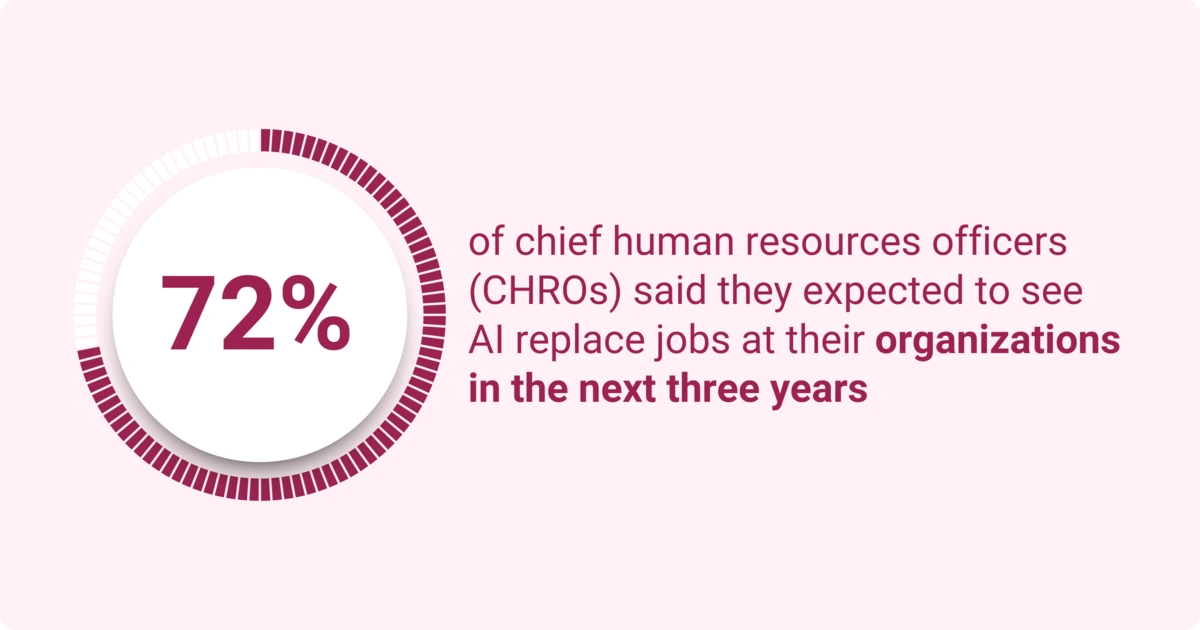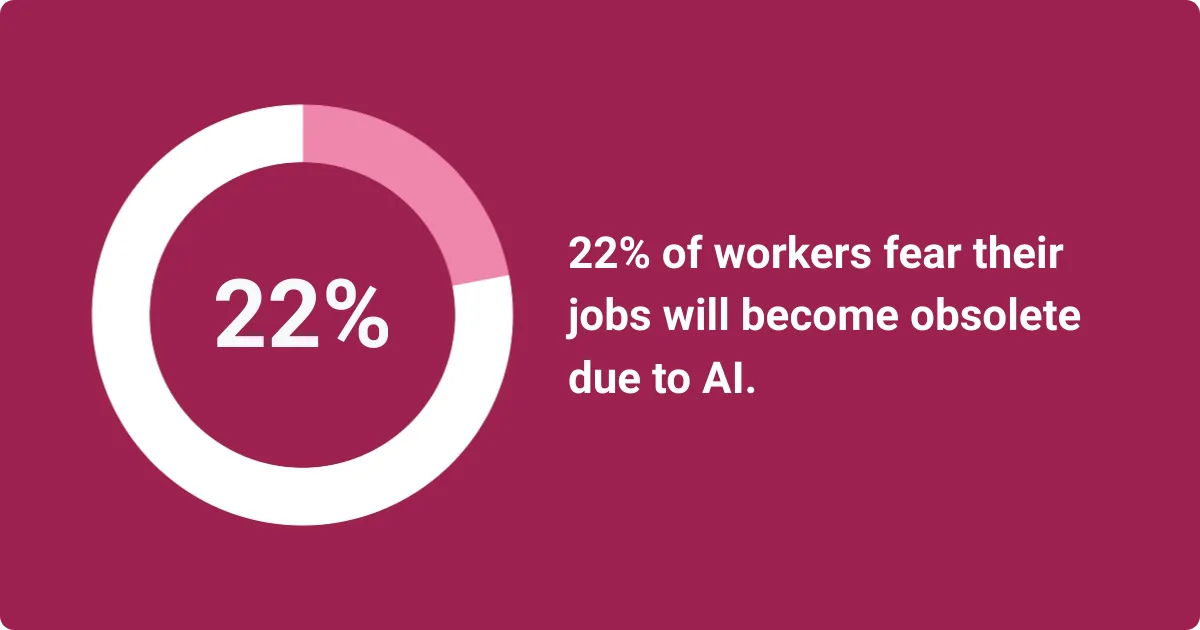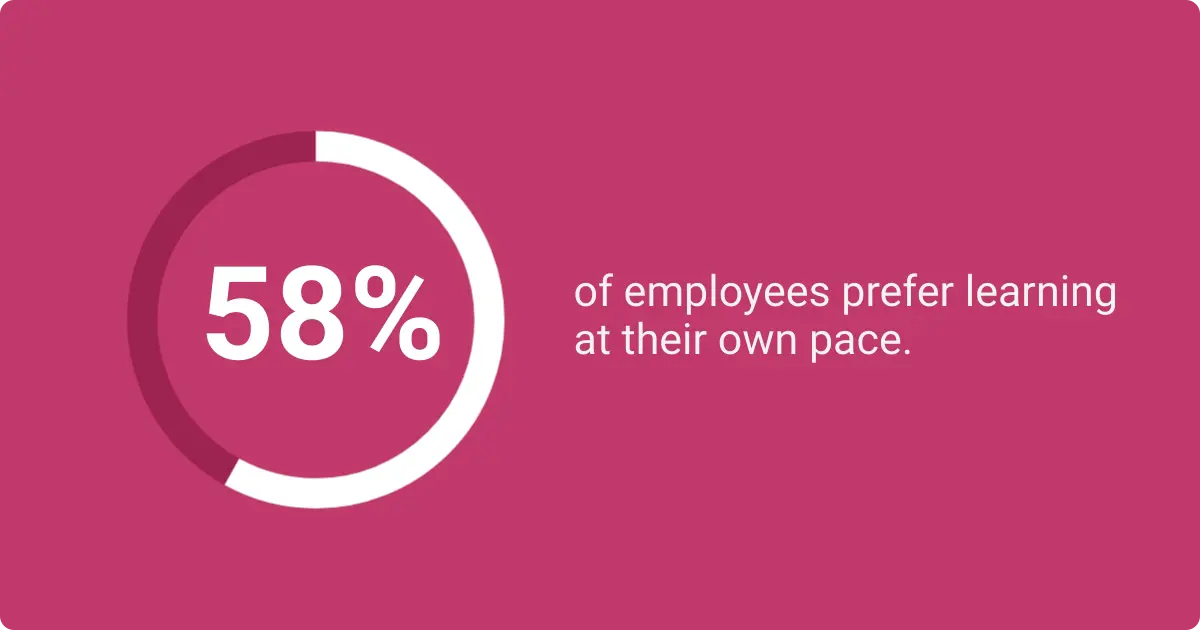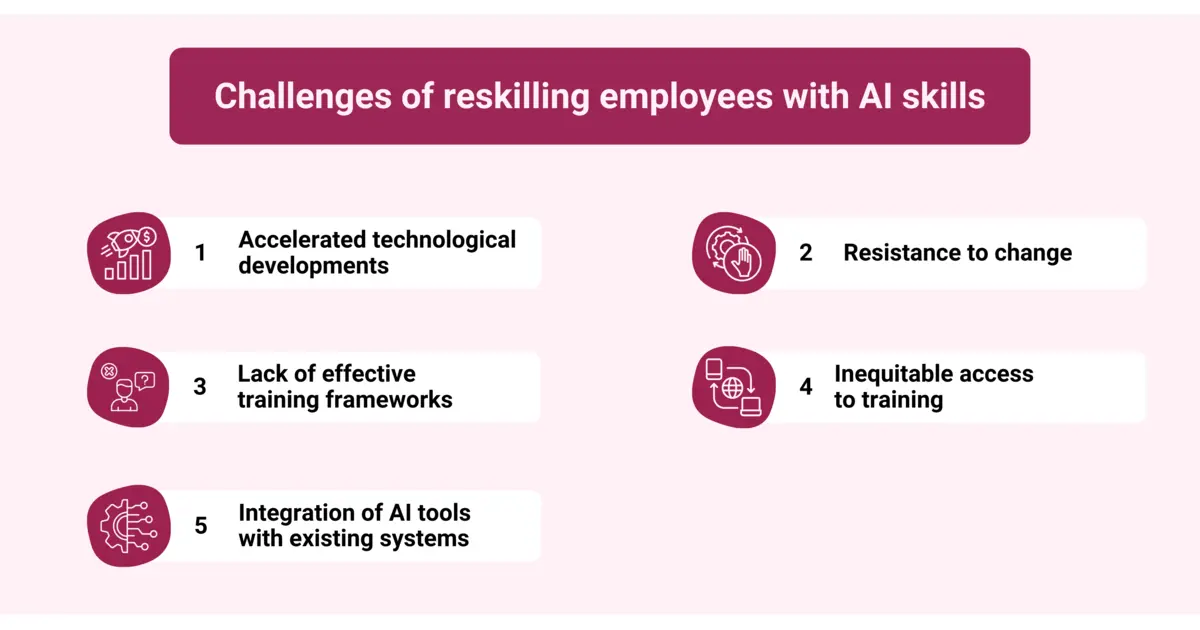Reskilling in the Age of AI: How to Future-Proof Your Workforce

AI isn’t coming for the workforce – it’s already here, disrupting industries and redefining job roles faster than most companies can adapt. From automated financial modeling to AI-generated marketing campaigns, businesses are witnessing entire functions transform overnight.
According to a 2024 Gallup survey on upskilling employees to adapt to the AI revolutionOpens in a new tab, 22% of workers fear their jobs will become obsolete due to AI, and 72% of CHROs expect AI-driven job replacements within three years.
But AI doesn’t have to be a threat – it can be a growth opportunity. The key? AI upskilling and reskilling.
The most successful companies won’t just replace jobs with AI – they’ll empower employees to work alongside AI by developing critical skills in automation, data analysis, and AI-driven decision-making. By investing in upskilling and reskilling in the age of AI, businesses can future-proof their workforce, retain top talent, and stay ahead of the competition.
Artificial intelligence is reshaping work
AI has evolved from a futuristic concept into a powerful, everyday tool, signaling a major shift in the fourth industrial revolution. Once reserved for large corporations, AI is now accessible across industries, transforming the way businesses operate and how employees engage with their work.
Traditionally, AI has been used to automate repetitive tasks such as data entry and scheduling. However, with recent advancements, AI is now capable of handling more sophisticated tasks, including writing, predictive modeling, and even coding.
While AI adoption drives efficiency and streamlines processes, it’s also reshaping the job landscape. Some traditional roles are disappearing, while new ones are emerging that require AI-specific skills.
Here are some examples of how AI is changing specific roles:
- Retail: AI-driven inventory management reduces the need for stock clerks, while creating demand for logistics analysts and supply chain experts.
- Marketing: AI automates ad targeting and content creation, shifting marketers’ focus to AI-driven personalization and strategy.
- Finance: AI algorithms handle fraud detection and risk assessments, lowering the need for human analysts but increasing demand for AI-savvy financial strategists.
- Healthcare: AI enhances diagnostics and robotic surgeries, reducing administrative roles but creating new opportunities for AI-trained medical professionals.
- Customer Service: AI chatbots handle basic inquiries, reducing entry-level jobs but increasing demand for AI system managers and customer experience specialists.
- Software Development: AI-generated code accelerates development, shifting focus to AI-enhanced engineering and AI ethics oversight.
As these capabilities continue to develop, businesses will need reskilled employees who understand how to use them, unlocking multiple benefits such as improved efficiency, innovation, and competitiveness, especially when leveraging AI in business intelligence for strategic insights.

What this means for workers and employers
As these technologies take over repetitive tasks, they create an opportunity for employees to focus on higher-value work. Reskilling provides employees with the opportunity to adapt, develop new skills, and remain in demand as businesses shift alongside AI-driven transformations.
For companies, investing in strategic reskilling programs is no longer optional – it’s a competitive necessity. Organizations that prioritize workforce AI-readiness will be better positioned to innovate, adapt, and lead in the AI-powered economy.
The critical role of reskilling
Investing in upskilling and reskilling is essential as AI reshapes industries. Without these programs, organizations risk falling behind as AI becomes increasingly integral to business operations. This isn't just about keeping pace with change – it's about staying competitive in an AI-driven world.
Enhancing competitiveness
Reskilling directly supports innovation, agility, and adaptability, giving businesses a competitive edge. A Gartner reportOpens in a new tababout the challenges and benefits of AI in human resources found that 76% of HR leaders believe their organizations will lag behind if they don’t adopt AI solutions—including generative AI—within the next 12-24 months.
More specifically, AI reskilling can help your business build a competitive edge by allowing you to identify and fill skill gaps. Leading companies are already reaping the rewards:
- Ericsson began its reskilling program in 2018, equipping thousands of employees with technical skills in AI and automation.
- Verizon launched its technology-focused reskilling program in 2021, with the goal of preparing half a million people for jobs of the future by 2030.
- Bank of America invested $25 millionOpens in a new tab in reskilling and upskilling to address skill gaps and help under-represented populations enter the tech job market.
The result of these and other forward-thinking programs has helped these companies achieve economic growth and strengthen their position in the global economy.

Greater job security
While AI’s rise may trigger concerns about job displacement, reskilling offers a proactive solution that turns potential risks into growth opportunities. Reskilled employees become more agile, prepared for evolving roles, and equipped to meet the dynamic needs of the business.
Closing the gap between AI usage and awareness requires direct education and training. A reskilling program encourages workers to implement AI within their workflows. This makes them more adaptable to workplace changes, improves their value to your organization, and prepares them for changing job markets and industry demands.
In combination, these improvements reduce the risk of job obsolescence and support greater job security. If AI does result in layoffs, reskilled employees are better positioned to take advantage of internal mobility, transitioning into new roles within the company rather than facing job loss.
How to implement effective reskilling in the age of AI
A successful reskilling program requires a structured, strategic approach that aligns with your company’s goals and prepares employees for the future.
To ensure your workforce is ready to adapt, follow this eight-step framework for implementing an effective AI reskilling program.
Step 1: Conduct an internal AI skills gap audit
First, perform a skills gap analysis to identify what weaknesses you need to address within your workforce. In addition to filling those gaps, employees will need to develop new skills, such as data visualization, machine learning, and cloud infrastructure.
Your team should also develop skills in areas that AI can't replicate:
- Critical thinking
- Communication
- Analysis and understanding of ethics
- Creativity
- Collaboration
- Conflict resolution
People with strengths in these areas have high value because they thrive in scenarios where AI offers little to no benefit.
Make smarter development decisions using the combined powers of AI and recognition—Human Intelligence™—to crowdsource authentic, sustainable skills insights.
Workhuman's latest product innovationOpens in a new tab helps you easily map and track employees' skills using recognition data. Identify gaps or find employees already recognized for key skills using the AI Assistant. Use open-ended prompts to answer questions like “Who on my team is qualified for X?” or finding potential mentors.
Step 2: Diversify learning approaches
No two learners are exactly the same, and their learning paths shouldn't be, either. Incorporating a variety of approaches in your reskilling program increases participation and engagement, making it more worthwhile for everyone involved.
When you develop your reskilling courses, consider including elements such as:
- Interactive assignments
- Video lectures
- Quizzes
- AI simulations
These activities give employees with different learning styles more opportunities to connect with the material and understand the information in different contexts.
Step 3: Develop tailored learning for diverse career paths
Although some subjects in AI reskilling are universal, others are specific to certain roles. Forcing employees to learn about subjects that don't align with their career advancement goals is likely to result in disengagement and lower employee retention.
Instead, create customized training that addresses the subjects most important to various roles and career aspirations.

Step 4: Build new skills with on-the-job training
Another common concern with reskilling is how much it will keep employees away from their existing work. While preparing workers for the future is critical, it shouldn't come at the expense of your current productivity.
On-the-job training can reinforce skills acquisition without disrupting your business operations. Rather than spending hours on a computer or in a classroom, employees can learn while doing jobs that contribute to your company's success.
Step 5: Encourage knowledge sharing
Employees often have differing levels of experience and skill with AI, and they can learn a lot from one another. Facilitating opportunities for them to share their knowledge and talents fosters a collaborative learning environment.
Your team members can help one another work through complex concepts and identify best practices for using these new technologies.
Step 6: Leverage AI tools
Creating an AI reskilling program from scratch is a time-consuming and potentially expensive endeavor, but AI tools can simplify and speed up the process. For example, some AI tools for training and development can create custom modules based on your company, employee population, and subjects of focus.
Many AI learning tools can also analyze student performance as they work through the reskilling program. The module adjusts to the learner's needs based on their comprehension of a certain topic.
With these capabilities, you can scale your reskilling program, making it available to a broader pool of employees. You should also see improved training outcomes, such as stronger knowledge retention and learner engagement.
Step 7: Upskill alongside reskilling
Pairing AI upskilling and reskilling helps employees learn the right skills needed for future positions and enhances their performance in their current roles. Upskilling programs with a technology focus make employees more adaptable to AI-driven transformations.
For example, AI upskilling might help a worker maximize their workflows and become more efficient. As a result, they can devote time to learning advanced strategies and skills. With a knowledge of AI, they can also analyze more challenging data and provide deeper insights for your business.
Step 8: Monitor progress and adapt
A strong reskilling program changes regularly to meet your business goals and account for employee performance. Use a skills assessment to make sure employees are achieving their objectives and understanding what they've learned.
Another helpful step is looking at performance metrics, such as:
- Program completion
- Average time to completion
- Employee engagement
- Skills improvement
- Knowledge retention
- Employee satisfaction
If you discover that a metric is lacking, modify your program to address the underlying issue. For instance, if skills improvement levels are low, try presenting information in different formats and styles.
Challenges of AI skills development
As you develop an AI reskilling program, you'll likely come across some bumps along the way. Many companies face obstacles during this process, but you can mitigate them through strategic planning and leadership support.
Accelerated technological developments
AI advancements have recently picked up the pace, often outstripping the speed at which organizations can adapt. Just as employees complete a reskilling program, you discover that new technologies requiring a different set of skills have emerged. This can make reskilling seem like a never-ending effort where it's impossible to keep employees' skills current.
This fatalistic view of reskilling undermines progress within your organization. The skills that employees gain today will serve as building blocks for the ones they'll need to develop down the road. In addition, having employees participate in programs in phases rather than all at once gives you the opportunity to update the training as advancements occur.
Resistance to change
Employees are sometimes reluctant to participate in AI reskilling because they're intimidated by the technology, have concerns about AI ultimately replacing their jobs, or find it difficult to adjust to new systems.
To overcome this hurdle, be clear and direct with employees about how reskilling will benefit them. Explain how it will support their professional advancement, potentially opening doors to promotions within the company.
Lack of effective training frameworks
Organizations also struggle to establish scalable and adaptable frameworks for delivering effective reskilling programs. One-size-fits-all frameworks often aren't effective at engaging employees and addressing their specific needs and learning styles.
Incorporating real-life experiences and hands-on projects rather than just reading or listening to information generally makes reskilling more successful.
Inequitable access to training
Favoritism and bias in the workplace can cause disparities in access to reskilling opportunities. For example, if a supervisor only allows a few preferred people to participate in reskilling, the program as a whole becomes less effective and fosters resentment among employees. Finding ways to avoid these biases is critical to implementing reskilling programs.
Integration of AI tools
AI is relatively unregulated at this stage, creating concerns about data privacy and the security of some AI tools. Organizations unfamiliar with tools may also struggle to find ways to incorporate them into their programs, especially if they don't integrate with existing systems and technologies.
Doing some research before selecting an AI tool for reskilling will prevent many of these headaches. Although they might require an upfront investment, allocating the budget to reputable AI tools will pay off as employee skill levels and productivity increase.

The future of reskilling and AI
Organizations need to stay on top of AI's continuous evolution and other emerging technologies to remain competitive and sustainable.
That means developing an awareness of upcoming trends, such as:
- AI-driven skills forecasting: AI can analyze data to predict future job market demands and identify necessary skills.
- Augmented reality (AR) training environments: Immersive training solutions allow employees to learn new skills as if they're out in the field or by working with a virtual piece of equipment that's not physically available.
- Lifelong learning ecosystems: AI offers tailored educational experiences throughout a person's lifetime. It gives access to ongoing and adaptive training content even after changing jobs or employers.
As these trends continue, you can expect to see new tools, software, and services that support your reskilling efforts.
One cutting-edge advantage from Workhuman is Human Intelligence, the combined power of recognition data and AI. Get a deeper understanding of your employees' skills, internal mobility opportunities, and the strengths of your HR programs.
Wrapping up
Many people view AI as an enemy that's upending business as they know it, but companies that avoid it altogether will fall behind. A healthier, more productive approach is to focus on human-AI collaboration. Empowering your employees to leverage technology helps them grow professionally and make more valuable contributions to your organization.
Reskilling is not just a strategy for survival—it's a path to thriving in the AI-driven future. Don’t wait for change to pass you by. Start building your AI reskilling program today to empower your workforce, ensure business continuity, and remain competitive.